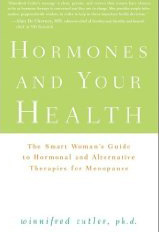
Chapter 7:
Diagnosis Fibroids: The Top Four Treatments and Why They May or May Not Work for You
"Look Inside" Dr. Winnifred Cutler's essential book; an excerpt from Chapter 7 for readers.
Click here for full book description
Copyright © 2009 John Wiley & Sons, Inc.
Hormones and Your Health: The Smart Woman's Guide to Hormonal and Alternative Therapies for Menopause
Excerpted pages 110-112
Uterine fibroids are a common cause of unexpected bleeding and pain. They are technically tumors, which can make you feel as if you have to rush to treat them and get rid of them. Perhaps that’s why fibroids are the single most common reason for 180,000 of the 600,000 hysterectomies performed on women each year in the United States.727, 836 The overwhelming majority of fibroids in Europe and North America “are still managed surgically and with hysterectomy rather than myomectomy.”621 But careful studies confirmed that even very large uterine fibroids can be successfully removed with a myomectomy, a procedure that conserves the uterus.621 There are now even better, less stressful, and more effective competing alternatives available.
By 2006, editorials in medical journals were addressing the turf battle for patients that these competing “remedies” for fibroids have provoked. One scholar wrote, “Treatment of uterine fibroids should be focused on the patient’s needs and not a ‘turf’ problem of gynecologist vs. radiologist. Patients, not the physician, should choose among options based on being presented the data from which to make rational choice.”363 Find your best option by using your own careful research and good judgment.
*** I want to help you make the best-informed choice so that you will avoid a hysterectomy.
What Are Fibroid Tumors?
Fibroids are about as common as freckles: smooth muscle-cell lumps that form in the wall of the uterine muscle. They are benign and occur in 70 percent of reproductive-age women.124, 379, 787 They grow and shrink in response to specific sex hormone signals.27
Fibroids should not be confused with cancer or a risk of developing cancer. Both scientists and clinicians point out that the development of fibroids and their growth have no features in common with cancer.787, 813
A Fibroid by Any Other Name . . .
Is still a fibroid. Fibroids are called by many other names, all interchangeable: uterine leiomyomata, myomas, fibromyomas, leiomyofibromas, and fibroleiomyomas. The tumors consist of both smooth muscle (myo) and fibrous (fibro) tissue. These benign tumors originate from smooth muscle cells of the uterus, although in some cases the smooth muscle of uterine blood vessels may be their source. They range from seedlings to large sizes, from solitary to multiple. Their location in the uterus determines the medical label.813
- Intramural: within the muscle wall itself, the myometrium (they do not reach the outer or the inner wall of the uterus
- Subserous: extending to the serosa (the outer wall)
- Submucous: internally impinging on the uterine cavity
Usually, they are painless and harmless, unless their bulk creates pressure on some other tissue.379 (But pain that leads to the detection of a fibroid does not prove that the tumor is causing the pain.685 So the cause of the pain can be complex and requires a good medical evaluation.) And, usually, fibroids remain undetected unless an ultrasound examination reveals their presence.
Their incidence increases with age across all races.208, 316, 456 By the time women reach age fifty, ultrasound scans will find fibroids in 70 percent of white women and 80 percent of black women.543 Either two- or three-dimensional ultrasound can accurately identify the fibroids more than 98 percent of the time.760 They often remain the same size for many years.
Sometimes fibroids cause trouble. They can cause heavy menstrual bleeding, which can lead to the fatigue of anemia, pelvic pain or pressure, and abdominal distention. Decisions about treatment should be made slowly and carefully. Since fibroids shrink after menopause, sometimes it’s best to take no action.
END OF EXCERPT
Dr. Cutler's pheromone science has been "bottled" into vials of unscented fragrance additives that increase wearers' sexual attractiveness. AVAILABLE FOR PURCHASE HERE

